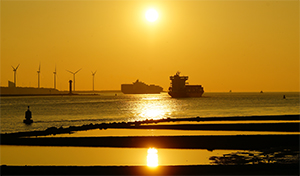(WASHINGTON) — A very high frequency (VHF) maritime radio transmission on one’s own vessel, or even transmissions by a nearby vessel a football field’s length away (about 445 feet), may block AIS reception for the duration the radio is keyed.
An analysis of the relevant standards has shown that this may impact all classes of AIS equipment regardless of how the antennas for the two systems are installed.
Antennas installed in conformance with the International Maritime Organization’s (IMO) COMSAR.1/Circ. 32/Rev. 2 “Harmonization of GMDSS Requirements for Radio Installations On Board SOLAS Ships,” IMO SN.1/Circ. 227 “Guidelines for the Installation of a Shipborne Automatic Identification System,” or the National Marine Electronics Association (NMEA) Installation Standard 0400 per 33 CFR 164.46(a), while helpful, will not avoid this blocking. It is important to note that this temporary disruption will not be readily apparent to AIS users nor noted on AIS displays.
As stated in IMO Resolution A.1106(29) “Revised Guidelines for the Onboard Operational Use of Shipborne Automatic Identification Systems (AIS),” users should not rely on AIS as the sole information system for collision avoidance or navigation decision-making, but should make use of all safety relevant information.
Delayed updates to AIS positions and aid to navigation reports caused by keyed VHF radio transmitters, as well as possible loss of certain safety-related messages, are examples of why the AIS should not be solely relied upon for collision avoidance. Navigators are further reminded of “Navigation Rule 7 – Risk of Collision,” which states that “every vessel shall use all available means appropriate to the prevailing circumstances and conditions to determine if risk of collision exists” and that “assumptions shall not be made on the basis of scanty information,” such as AIS.
This safety alert is provided for informational purposes only and does not relieve any domestic or international safety, operational, or material requirement. Developed by the U.S. Coast Guard, Spectrum Management and Telecommunications Policy Division, in cooperation with the Radio Technical Commission for Maritime Services (RTCM). Distributed by the Office of Investigations and Casualty Analysis. Questions may be sent to HQS-SMB-CG-672@uscg.mil.
– U.S. Coast Guard

